All nut and bolt sizes are given for the spanner size required to fit them.
Skill Level : 2. Dirty Level : 1. Work Mess Level : 1. Tools level : 2 : Space required : 1
Tools required : T-handled screwdriver; vacuum gauges, long thin screwdriver, 8mm spanner.
My vacs are made by Davida - highly recommended. - they are about 30 years old and still work perfectly. In 2017 they went off to Davida for a calibration check, and were found to be perfect, and even came back with new rubber hoses!
If you need spare parts for your carburettors, try NRP
Time (after petrol tank, air filter, airbox and fairing removal): expert 10 minutes, average 15 minutes, "first-time" 20 minutes.
All the hands, tools, and bike in the photos are the author's. In some of the photos I have had to wipe my hands clean before using the camera.
This page will show you how to balance the carburettors on your Deauville. This can be done any time you like but is best tackled if you have the side fairings removed for some other work to be done.
These instructions do not apply to the 700 Deauville, which has fuel injectors instead of tradtional carburettors. If you have the unfaired NTV650, ignore the instruction to remove the side fairings.
I am very receptive to comments and suggestions, but you use these pages entirely at your own risk.
What is this procedure and why do I need to do it?
 the
Red Fox says : "Let's begin by looking at what the
carburettors actually do and how they work."
the
Red Fox says : "Let's begin by looking at what the
carburettors actually do and how they work."
Petrol from the fuel tank is drawn off by an electric fuel pump, through a filter and then fed to both carbs. Each carb has a small chamber or reservoir on its underside, which works rather like a toilet cistern. It stores a small amount of fuel ready for use, and as the engine runs and uses up from this small reservoir, a float in the chamber drops as the fuel level drops, opening a small valve which allows more fuel back in. As this is used up, the fuel level drops again and opens the valve. This reservoir is called the float chamber or the float bowl.
One common reason for carbs to leak fuel is when this tiny float valve either sticks open, or is jammed open by a small piece of rust or debris.
As you open the throttle, the cables pull on a spring loaded lever which, on each carb, opens a circular valve, called a butterfly valve, between the carb and the cylinder inlet. This valve is actually a slim circular plate, hinged across the middle, and when closed by the spring, blocks off the passage between the carb and the engine, preventing fuel from going into the engine.
As the butterfly valve opens and the engine starts to suck in more fuel, a vacuum develops inside the carburettor body. This space is called the venturi. The vacuum is transferred up small passages inside the carburettor body to the upper part of the carb where the low pressure pulls up against a piston, which is very lightly spring loaded in the opposite direction. As this piston is sucked up the body of the carb, a long slender and tapered needle attached to its underside is also raised. The bottom end of the tapered needle is inserted into a brass plug with a hole in its centre. This is called the jet and the underside of it is immersed in fuel inside the float chamber. As the tapered needle rises, pulled up with the piston, the jet hole gets bigger.
The vacuum in the venturi sucks up fuel from the float chamber and this fuel passes up the jet aperture and sprays into the venturi. At the rearmost part of the carb is the large intake tract which is attached to the airbox and the air filter inside it. The spraying fuel is vapourised in the rush of incoming air (like an aerosol spray) and sucked past the open butterfly valve into the engine, where it is burned by the sparking plug.
When you close or reduce the throttle, the throttle return spring closes the butterfly valves, shutting off some or all of the fuel/air mixture, the vacuum in the venturi decays, the pistons are pushed back down by their light springs, and the tapered needle is lowered back into the jet, reducing the size of the jet aperture and thus reducing the amount of fuel which the engine can suck in.
Cast into the side of each carb body is a small device known as an air enrichment valve. This consists of a small chamber with one passageway feeding fuel straight through to the inlet tract. This passageway is normally shut off and blocked by a rubber diaphragm, pushed into the passageway by a coil spring. However, when the throttle is shut off, vacuum in the inlet tract sucks open these diaphragms and allows a tiny amount of neat fuel into the engine. This prevents popping and backfiring. These rubber diaphragms tend to either perish, crack, or degrade, especially if the bike is stored for long periods. This is easily fixed by removing the two tiny screws which hold on the covering plate, and replacing the diaphragm, spring, and tiny washer.
Ok so far? You'll see that there are two carburettors doing this, and like a cart with two horses, unless both horses are pulling with equal strength, the cart won't get maximum performance. If the left hand horse pulls harder than the right hand horse, one has an easy time and the other one works too hard. With carbs, they should be working in exact synchronisation, both delivering exactly the same amount of fuel/air mixture at exactly the same time.
Balancing the carbs means testing the amount of work each carb is doing and adjusting them so that they work as a perfect pair.
Symptoms of unsynchronised or unbalanced carburettors
1 Poor or erratic idle speed. A fully warmed Deauville engine should normally idle at 1,100 rpm and idle quite comfortably and without any hunting (idle speed rising and falling by itself) at 1,000 rpm. A properly balanced warm engine will idle as low as 500 rpm, and how low this will actually go before the engine stalls is a very good test of how well the carbs are balanced. If your engine won't idle cleanly at 800 rpm, then the carbs are out of synchronisation.
2 Poor fuel consumption. Assuming a 650cc with a standard exhaust, anything consistently less than 55 mpg (Imperial gallons, 8 pints) suggests either that you are riding too hard or that the carbs are out of synch.
3 Poor performance. There are several reasons why performance might be down and this is just one of them.
Popping or backfiring, especially on the over-run, is not usually caused by unbalanced carbs; but synchronising them is part of the cure.
Procedure
Warm the engine to its normal working temperature.
Turn the fuel off and then remove the petrol tank.
Remove the air filter and its box. The Haynes manual claims that there is a hole through the middle of the air filter housing, but on my V4 variant Deauville, the hole was blanked off. Maybe with an earlier variant, you're more fortunate and you don't have to remove the airbox - you'll have to play that one by ear.
Remove both side fairings (sorry - no way around this tedious task - unless you have the NTV650!)
In order to see how much work each carb is doing, you need to measure the amount of vacuum inside each of the inlet tracts, as the degree of "suck" here is dictated by the carburettor mechanism.
This requires a pair of vacuum gauges (right). These can be an expensive purchase, but a good set will last you a lifetime.
You cannot balance the carbs without vacuum gauges. On choosing a set, specify the oil-damped type as the needles on the cheaper vacs will pulse and fluctuate as the engine runs, making visible comparisons between the two readings rather more difficult.
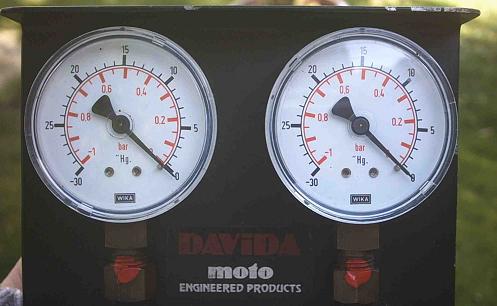
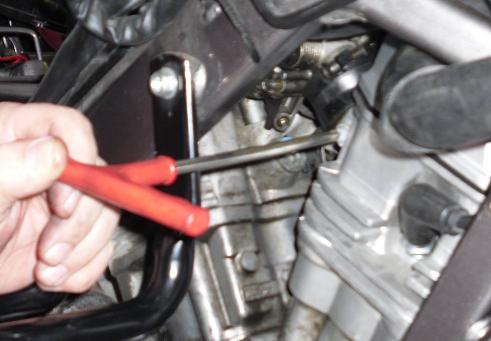
On each inlet tract, remove the small screw and washer which closes off the vacuum ports.
The Deauville's right hand port is easily seen just behind the front cylinder head, on the tract leading from the carburettor to the cylinder head.
Remove the screw from the intake tract and then screw one of the adapters from your vacs into the exposed hole. I find it easier to slip the adapter off its rubber hose, screw it into the cylinder head port, and then push the rubber hose back on again.
William
Allen gives the useful information that "Honda actually
sells these 'vac adaptors' as a genuine Honda part number ie, 16214-MB0-000
Joint, Booster also called Honda part code 1244193 and the
associated little sealing washers are Honda part number
90452-323-000 Washer,Sealing 5mm also called Honda part code
0255224."
He adds "These are a couple of additional small genuine Honda parts, which if also used, will then allow you to leave the little Honda 'vac adaptor' (Joint, Booster) permanently in place on the 'right hand' intake port of the front cylinder of the Deauville, instead of having to temporarily remove and then replace the standard vacuum off-take screw / plug each time when balancing the carbs. These two extra little Honda parts required are described as 16215-MV4-000 Cap, Booster and 95002-02070 Clip, Tube (B7)."
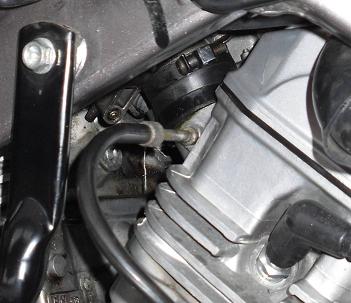
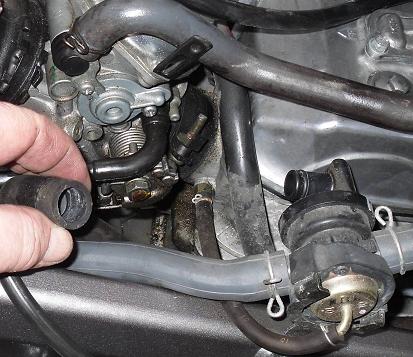
The left hand port is rather more difficult to reach. To gain access, locate the thick rubber hose running forwards from the oil breather device. Use pliers to loosen its spring clip and then slide it off the mechanism and tuck the pipe out of the way.
Now use pliers again to loosen the spring clip at the engine end of the slim pipe seen here curving underneath.
Once the slim pipe is off, reach in with an 8mm spanner and unscrew the left hand (rear) cylinder tract's port screw. Attach the other adapter from your vacuum gauges and its rubber pipe. It's quite fiddly to get your fingers into this confined space.
Now both cylinders have their intake tracts connected to your vacs and you can start the synchronisation process.
If like me you've graduated from any variant of the CX500 range, you'll be pleased to know that the rest of the exercise is easy!
Philip
Crofts adds : "Just a note that may or may not help, when
I balanced my carbs, I simply connected the gauge to the in-situ, left
hand inlet (which is linked to the advanced airflow control system pipe)
at the top end rather than undo the nut at the barrel end (as it was straight
through anyway) and it seemed to do the trick."
Run the engine and set the idle speed to exactly 1,100 rpm. Check the readings on the vacuum gauges. It does not matter what they are, as long as they are exactly - and I mean, EXACTLY - the same.
Even a needle width's difference will require adjustment! Don't be tempted to say "Oh, that'll do, that's near enough."
I'm afraid the flash from the photo made the left hand gauge disappear, so I've artificially enhanced where the reading was when I did this job. As you see, the carburettors were comprehensively out of synchronisation!
If they are precisely in synch, you're in luck. Remove the gauges, replace the port screws, you're done.
Usually, they aren't. Read on.
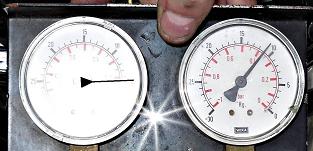
A Balancing Act
Although the two carbs are expected to work as a matched pair, the throttle cable only operates on the left hand (rear cylinder) carb. The other one is linked to the mechanism by a spring loaded bar which is retained against the other carb's mechanism by a small adjusting screw. Twiddling this screw makes minuscule adjustments in the way the left mechanism sits in relation to the right mechanism.
This linkage is not under any great force, and you'd think that once it was set up, it'd never need re-adjusting. However, factors such as inlet and exhaust valve wear, piston and fuel jet wear, general engine deterioration, and how many munchies the cat had for breakfast means that as the thousands of miles go by, the carbs gradually drop out of tune with one another.
Gilbert Despeghel
adds (December 2018) : "Something I always do before (re)balancing
the carburettors, is to connect ONE carburettor-vacuum PORT to BOTH
vacuum gauges with a" Y" 3-way adapter. This way I can be
sure that both gauges are reading the same value.
Doesn't matter which vacuum port you select...it's just to be sure that
your gauges are working properly."
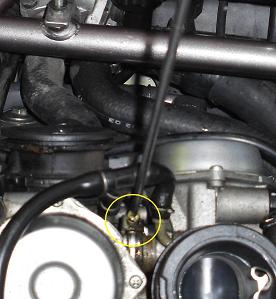
With the engine still idling, locate the adjusting screw between the carburettors - here, the screw is ringed in yellow - and whilst watching the vacuum gauge needles, tweak the screw one way or the other until the gauges both read precisely the same. It doesn't matter what the reading is - just ensure that they are 100% identical on both carburettors.
This will probably alter the idle speed - reset it to 1,100 rpm and check the vacs again. Do this until the idle is comfortable at 1,100 and the vacs are still reading identically. Give the engine some good bursts of throttle and check the vacs after each one.
When you are satisfied that the readings are correct, remove your screwdriver and drop a blob of locking compound or silicone sealant on the adjusting screw, so it can't be affected by any vibration.
This is definitely worth all the trouble. A well balanced engine sounds terrific, and purrs like a kitten when you trundle along at 30 mph in top gear - as well as idling easily and cleanly.
As a test of your success, try temporarily reducing the idle speed to 600 or 500 rpm, your freshly balanced carbs should handle this without the engine stalling.
An extended adjustment session will mean that the carburettors are emptied of fuel. Rest the petrol tank on its mounts and reconnect the petrol supply temporarily, to allow the float chambers to refill.
Then take the tank off again and continue your balancing act. If you can rig up a temporary fuel feed, this is a good idea, but don't spill petrol on the hot exhaust.
Remove your vacs and their pipes, unscrew their adapters and replace the right hand intake tract screw and the left hand piping and intake tract screw. Don't omit the steel washer between the screw and the cylinder head.
Replace the air filter housing and air filter, side fairings and petrol tank.
You're done! Comments and suggestions are welcomed via the main Web Resource page.